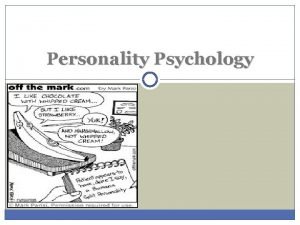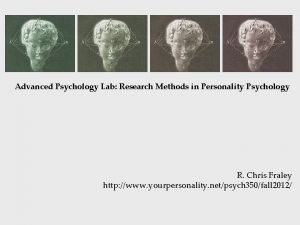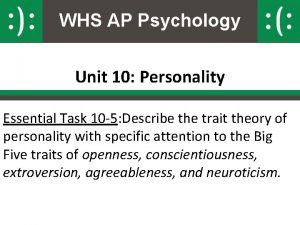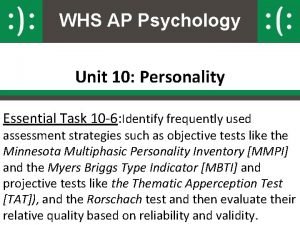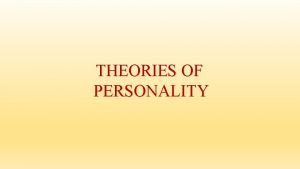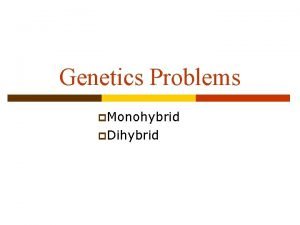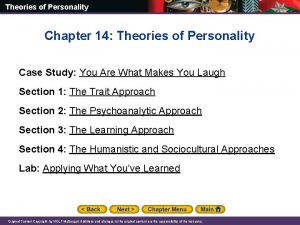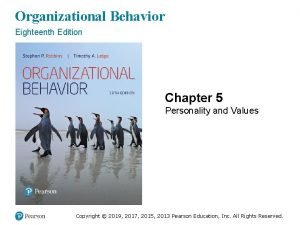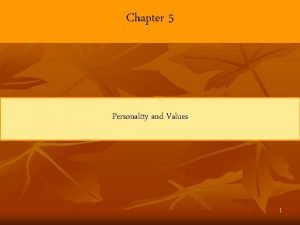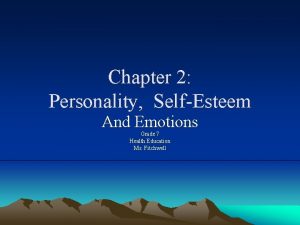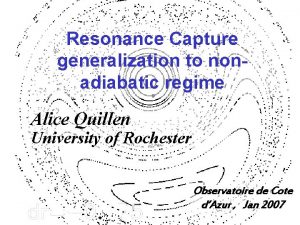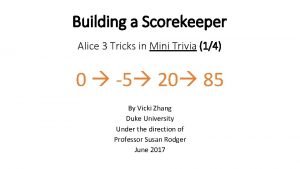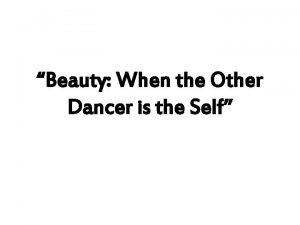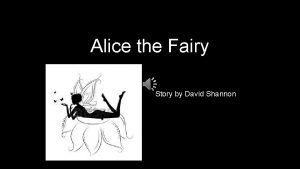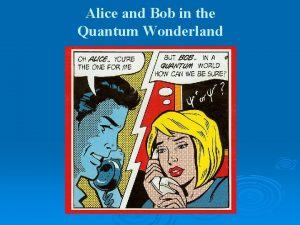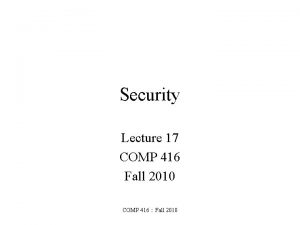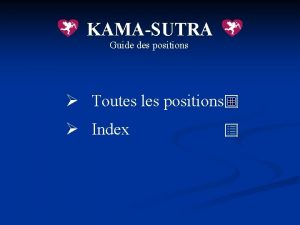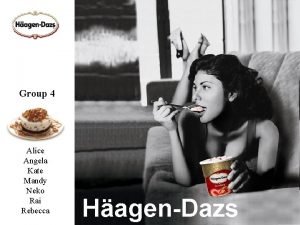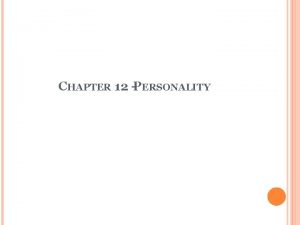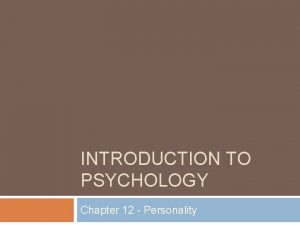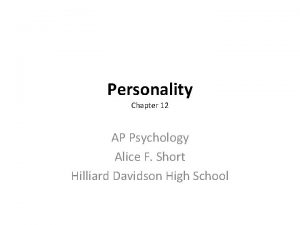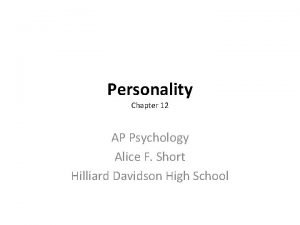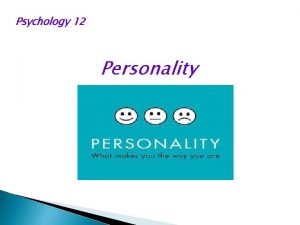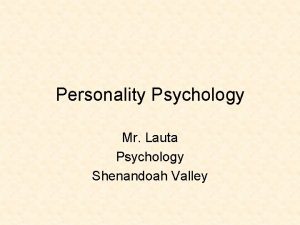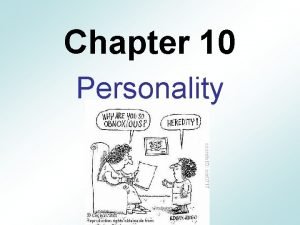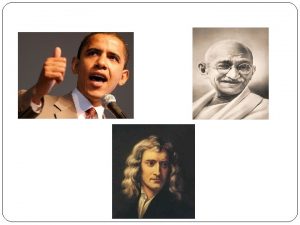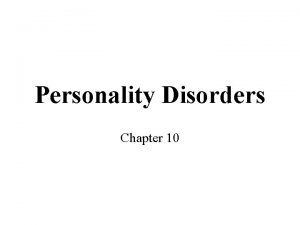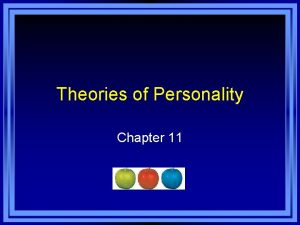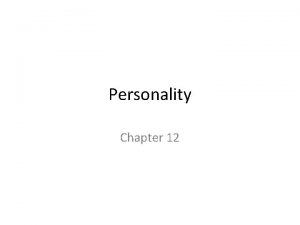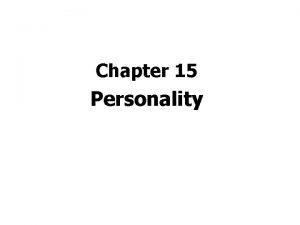Personality Chapter 12 AP Psychology Alice F Short














































































- Slides: 78

Personality Chapter 12 AP Psychology Alice F. Short Hilliard Davidson High School


Chapter Preview • • Psychodynamic Perspectives Humanistic Perspectives Trait Perspectives Personological and Life Story Perspectives Social Cognitive Perspectives Biological Perspectives Personality Assessment Personality and Health and Wellness

Personality • personality - a pattern of enduring distinctive thoughts, emotions, and behaviors that characterize the way an individual adapts to the world – Psychologist who study personality focus on the enduring traits and qualities we demonstrate over time.

Psychodynamic Perspectives psychodynamic perspective – theoretical views emphasizing that personality is primarily unconscious (beyond awareness) – how the unconscious impacts personality – unconscious because they MUST be • understanding personality involves exploring the symbolic meanings of behavior and the unconscious mind • early childhood experiences sculpt the individual’s personality

Psychodynamic Approach: Freud • Known as the founding father of the psychodynamic approach • Believed that there are unlearned biological instincts (especially of a sexual and/or aggressive nature) that can occur early in life and these instincts influence how a person thinks, feels, and behaves • Had a couch

• “I cannot think of any need in childhood as strong as the need for a father's protection. ” • “The great question that has never been answered, and which I have not yet been able to answer, despite my thirty years of research into the feminine soul, is 'What does a woman want? ‘” • “Love and work are the cornerstones of our humanness. ” • “The interpretation of dreams is the royal road to a knowledge of the unconscious activities of the mind. ” • “America is the most grandiose experiment the world has seen, but, I am afraid, it is not going to be a success. ” • “Dreams are often most profound when they seem the most crazy. ” • “I have found little that is 'good' about human beings on the whole. In my experience most of them are trash, no matter whether they publicly subscribe to this or that ethical doctrine or to none at all. That is something that you cannot say aloud, or perhaps even think. ” • Men are moral than they think and far more immoral than they can imagine. ” Freud Quotes

Freud’s Psychoanalytic Theory • Freud and Psychoanalysis – sex drive – main determinant of personality development – sex = organ pleasure (anything pleasurable is sex) – Freud: places stronger biological emphasis than the sociocultural, humanistic and social cognitive • Hysteria – physical symptoms without physical cause – overdetermined – multiple unconscious causes • Iceberg Analogy of Human Personality

Personality Structure • Freud

Personality Structure • Id (the “I”) – instincts and reservoir of psychic energy – pleasure principle • Ego • can be the pleasure of punching someone in the face that annoys you – deals with the demands of reality • reality principle – balances the needs of id, superego and reality • your internal referee • Superego (the “above-I”) – moral branch of personality; “conscience” – can make you feel good or bad

A SHORT ACTIVITY Activity Handout 12. 1 • Rachel is walking to class and the late bell rang two minutes ago. As she walks into her class, she stumbles and her books go flying everywhere. Out of one of the books is a note to a boy that Rachel has secretly liked for a long time. The boy picks up the note and reads the top line and then hands it back to Rachel. She is so embarrassed. – Id: – Ego: – Superego:

A SHORT ACTIVITY Activity Handout 12. 1 • Rachel is walking to class and the late bell rang two minutes ago. As she walks into her class, she stumbles and her books go flying everywhere. Out of one of the books is a note to a boy that Rachel has secretly liked for a long time. The boy picks up the note and reads the top line and then hands it back to Rachel. She is so embarrassed. – Id: scream, runaway – Ego: calmly collect belongings and proceed to class – Superego: judge Rachel for being so foolish

A SHORT ACTIVITY Activity Handout 12. 1 • Jake is going on his first date with a really popular girl. He still can’t believe that she agreed to go out with him. During the movie they are sitting so close that their legs are touching and he so badly wants to hold her hand kiss her, but he isn’t sure how she would react. He takes a chance and does it and she looks at him and then gets up and walks out. – Id: – Ego: – Superego:

A SHORT ACTIVITY Activity Handout 12. 1 • Jake is going on his first date with a really popular girl. He still can’t believe that she agreed to go out with him. During the movie they are sitting so close that their legs are touching and he so badly wants to hold her hand kiss her, but he isn’t sure how she would react. He takes a chance and does it and she looks at him and then gets up and walks out. – Id: kiss her more – Ego: apologize to her – Superego: feel guilty

A SHORT ACTIVITY Activity Handout 12. 1 • Jessica is babysitting for the same family she baby sits for every Friday night. This Friday night, however, she invited her boyfriend over and they are snuggled on the couch, watching a movie. The parents come home early and find Jessica and her boyfriend wrapped in each others’ arms and sound asleep. They wake them up and are so upset because they felt as though Jessica was irresponsible. Jessica is really upset and not sure what to think or say. – Id: – Ego: – Superego:

A SHORT ACTIVITY Activity Handout 12. 1 • Jessica is babysitting for the same family she baby sits for every Friday night. This Friday night, however, she invited her boyfriend over and they are snuggled on the couch, watching a movie. The parents come home early and find Jessica and her boyfriend wrapped in each others’ arms and sound asleep. They wake them up and are so upset because they felt as though Jessica was irresponsible. Jessica is really upset and not sure what to think or say. – Id: spend more time with boyfriend – Ego: apologize to the parents and promise not to do it again – Superego: feel guilty

A SHORT Time to Ponder Small Group Discussion • Do you think that the iceberg analogy works well to describe your personality. Why? • Why do you think Freud came up with this personality structure with an id, ego and superego? • How much do you think your childhood experience will influence your adulthood? • How does Freud’s definition of sex differ from other people’s definitions? (reference textbook or notes)

A SHORT Task: Explaining the Id, the Ego and the Superego Activity Handout 12. 2 • Think of your three closest friends. Write down their names in the space provided and then put a check next to the space of the personality trait that your friend has. They can have more than one personality trait. After completing every one, go back, and in the space provided briefly explain what this tells you about your friends. – – – Name: Neuroticism: ____ Extraversion: ____ Openness to Experience: ____ Agreeableness: ____ Conscientiousness: ____ – Explanation: Pay special attention to this part! You will be discussing this with a neighbor and they will be evaluating how accurate you are.

Explaining the Id, the Ego and the Superego Activity Handout 12. 2 • Think of your three closest friends/Disney princesses/fictional characters/someone you create. Write down their names in the space provided and then put a check next to the space of the personality trait that your friend has. They can have more than one personality trait. After completing every one, go back, and in the space provided briefly explain what this tells you about your friends. – – – Name: Neuroticism: ____ Extraversion: ____ Openness to Experience: ____ Agreeableness: ____ Conscientiousness: ____ – Explanation:

Explaining the Id, the Ego and the Superego Activity Handout 12. 1 • Neuroticism: anxious, insecure, self-pitying • Extraversion: sociable, fun-loving, affectionate • Openness: Imaginative, interested in variety, independent • Agreeableness: softhearted, trusting, helpful • Conscientiousness: organized, careful, disciplined • IN CLASS ACTIVITY: Trade and discuss with a neighbor to see if they successfully explained the characteristics. (Alternate between people)

Defense Mechanisms • conflict between the id, ego, and superego results in anxiety • defense mechanisms reduce anxiety by unconsciously distorting reality – not necessarily unhealthy • Repression (defense mechanism #1) – foundation for all defense mechanisms – push unacceptable impulses out of awareness

Defense Mechanisms 1. 2. 3. 4. 5. 6. 7. 8. repression rationalization displacement sublimation projection reaction formation denial regression

A SHORT Activity • “AP Psych – Ch 12 – Defense Mechanism Activity” • Count students off by the number 8. Hand each group there assignment. • Take approximately 15 -20 minutes to prepare to present on your assigned defense mechanism. • Present!! (see next slide)

Mini-Presentations 1. State assigned definition and explanation. 2. State any other defense mechanisms with which yours may be confused (if any), and explain how you can identify yours in comparison. 3. Provide example(s) to class. – one narrative example per note card – don’t include answer anywhere in narrative 4. Answer any questions.

1. repression – – pushes unacceptable impulse out of awareness application: forgetting details of traumatic event Defense Mechanisms 2. rationalization – replace less acceptable motive with a more acceptable motive 3. displacement (feeling from unacceptable more acceptable) – shifts feelings toward an unacceptable object to another, more acceptable object 4. sublimation – – – replaces an unacceptable impulse with a socially acceptable one application: taking socially unaccepted feelings (like aggression) and putting them towards something socially accepted (sports) application: liking violence becoming a soldier / playing video games

5. projection – – Defense Mechanisms attributes personal shortcomings, problems, and faults to others application: you cheat you accuse significant other of cheating/wanting to cheat 6. reaction formation – – – transforms an unacceptable motive into its opposite looking at pornography becoming a vocal advocate against pornography Eliot Spitzer 7. denial – – refuses to acknowledge anxiety-producing realities working on bomb squad not worrying about safety 8. regression – – – seeks the security of an earlier developmental period in the face of stress seeking your parents / childhood bedroom for comfort in adulthood adopting childlike characteristics

Defense Mechanisms

Defense Mechanisms Defense mechanism can be beneficial to psychological health!

Freud: Psychosexual Stages • erogenous zones – parts of the body that have especially strong pleasuregiving qualities at particular stages of development – Freud: adult personality shaped by conflict b/w these early sources of pleasure and the demands of reality • Oral Stage: 0 -18 Months – infant’s pleasure centers on the mouth • Anal Stage: 18 -36 Months – child’s pleasure involves eliminative functions • Phallic Stage: 3 -6 Years – child’s pleasure focuses on the genitals – Oedipal complex – according to Freud, a boy’s intense desire to replace his father and enjoy the affections of his mother – castration anxiety – the boy’s intense fear of being mutilated by his father • reduce conflict identifies with father, adopts male gender role – girls: castration complete penis envy • Freud believed that a penis was necessary for the full development of the superego; thus, females are morally inferior to men.

Psychosexual Stages fixation - remaining locked in particular developmental stage (not a defense mechanism) sublimation – replacing an unacceptable impulse with a social acceptable one reaction formation – transforming an unacceptable motive into its opposite

Psychosexual Stages (cont. ) • Latency Stage: 6 Years - Puberty – psychic “time-out” – interest in sexuality is repressed • Genital Stage: Adolescence and Adulthood – sexual reawakening – source of sexual pleasure is someone else – 2 hallmarks for maturity: love and work • fixation - remain locked in particular developmental stage (e. g. , anal retentive) – CAREFUL: This is NOT a defense mechanism!

Fixation • Oral Stage Fixation – biting nails and pencils • Anal Stage Fixation – keeping home and workspace spotless, arranged in specific and organized way, agitated if something is moved • Phallic Stage Fixation

Dissenters and Revisionists • sexuality – not pervasive force behind personality • early experience – not as powerful as Freud thought • importance of conscious thought • sociocultural influences

• Karen Horney’s Sociocultural Approach Dissenters and – both sexes envy the attributes of the other Revisionists • women might envy the penis, but what they really want is the status bestowed on those who have one – need for security, not sex, is primary motivator • Carl Jung’s Analytical Theory – collective unconscious – the deepest, impersonal layer of the conscious mind that is shared by all humans • archetypes – emotionally laden ideas and images that have rich and symbolic meanings for all people archetypes (expresses the collective unconscious) – predisposition to respond the environment in particular ways – persona – can be adopted in different circumstances

A SHORT Time to Ponder • Explain how you think the time period and culture influenced both Freud’s and Horney’s views. • How do you think your time period and culture influence your views?

• Alfred Adler’s Individual Psychology – individual psychology – Adler’s view that people are motivated by purposes and goals – perfection, not pleasure, is key motivator • compensation - people desire to overcome their perceived shortcomings (replace feelings of inferiority with feelings of superiority) – birth order = important to personality development • middle child = best Dissenters and Revisionists

Evaluating Psychodynamic Theory • Criticisms – too much emphasis on early experiences – too much faith in unconscious mind’s control – too much emphasis on sexual instincts – theory can not be tested – too much loyalty to Freud (serious) • Contributions – importance of childhood experiences – development proceeds in stages – role of unconscious processes

Humanistic Perspectives • humanistic perspective - emphasis on a person’s capacity for personal growth and positive human qualities – “third force” psychology – stressed neither Freudian drives nor the stimulus-response principles of behaviorism – assumption: human nature = essentially good – innate ability to cope with stress, control lives, and bring about positive outcomes – Individual = process of change – humanistic counseling • evaluate self • not depending on opinion of others

Humanistic Perspectives • Abraham Maslow – third force psychology • not Freudian drives • not behaviorism (stimulus-response) – self-actualization – the motivation to develop one’s full potential as a human being • spontaneous, creative, possessing a childlike capacity for awe • peak experiences/moments – breathtaking moments of spiritual insight • biased since focus was on highly successful individuals (Thomas Jefferson, Eleanor Roosevelt, William James, etc. )

Humanistic Perspective • Carl Rogers – research led to modern studies: personal growth and self-determination – unconditional positive regard – Roger’s construct referring to the individual’s need to be accepted, valued, and treated positively regardless of his or her behavior • conditions of worth – the standards that the individual must live up to in order to receive positive regard from others • self-concept – our conscious representation of who we are and who we wish to become – optimally: reflects our genuine, innate desires – : can be influenced by conditions of worth – empathy – genuineness – born with raw ingredients for fulfilling life need right conditions to thrive

Evaluating Humanistic Perspectives • Contributions – self-perception is key to personality – consider the positive aspects of human nature – emphasize conscious experience • Criticisms – too optimistic about human nature – promotes self-love and narcissism

A SHORT Time to Ponder • Can changing your feelings about yourself increase your happiness? • Do you think that the humanistic approach promotes self-love and narcissism?

Trait Perspectives • Trait – an enduring disposition that leads to characteristic responses – traits are the building blocks of personality • Trait Theories – theoretical views stressing that personality consists of broad, enduring dispositions (traits) that tend to to lead to characteristic responses – people can be described by their typical behavior – strong versus weak tendencies • “high” or “low” on traits

Trait Perspectives • Gordon Allport – – father of American personality psychology personality understood through traits behavior consistent across situations lexical approach 4500 traits • W. T. Norman – factor analysis – statistical procedure (here, to categorize) – five factor model • identifies which traits go together in terms of how they are related – big five factors of personality – the five broad traits that are thought to describe the main dimensions of personality: neuroticism (emotional instability), extraversion, openness to experience, agreeableness, and conscientiousness – broad traits – main dimensions of personality

Five Factor Model of Personality: OCEAN A SHORT Time to Ponder: Do you think that there should be another trait here?

Five Factor Model of Personality • Do the big five show up in the assessment of personality in cultures around the world? • Do the big five personality traits show up in animals?

Evaluating Trait Perspectives • HEXACO model – incorporates sixth dimension: honesty/humility (moral dimensions of personality • Contributions – traits influence health, cognitions, career success, and interpersonal relations • Criticisms – ignores the role of the situation in behavior – ignores nuances of an individual’s personality

TED Talks • Online Dating broken down!

Personological and Life Story Perspectives • personological and life story perspectives - focusing on an individual’s life history or life story • Henry Murray – thank you for making Criminal Minds possible – personology: the study of the whole person • created first profile: Hitler (predicted suicide) – motives are largely unconscious (22 different needs) • need for achievement • need for affiliation • need for power – thematic apperception test (TAT) – w/ Christiana Morgan • need for achievement, affiliation, and power – less interested in specific traits

Personological and Life Story Perspectives • David Winter (2005) – Sate of Union Addresses • Achievement (Carter) – judged as less successful • Power (Kennedy, Reagan) – judged as successful • Affiliation (Nixon) - scandal

Life Story Approach • Dan Mc. Adams (in footsteps of Henry Murray) – developed life story approach to identity – our life story is our identity – intimacy motivation – an enduring concern for warm interpersonal encounters for their own sake – RESEARCH: college men scoring high on intimacy better health and happiness 30 years later • psychobiography – applying personality theory to one person’s life

A SHORT Time to Ponder • If identity is so tied to your memories, what happens to the identity of someone who suffers from amnesia?

Evaluating Life Story Approach • Contributions – rich record of an individual’s experience • Criticisms – difficult and time-consuming • extensive coding and content analysis – prone to bias – not easily generalized

Social Cognitive Perspective • emphasize conscious awareness, beliefs, expectations, and goals – stresses the interaction of thought with social environment • incorporates principles from behaviorism when exploring: – reasoning – Why do we behave differently in different situations? – beliefs – self reflection – interpretation of situation

Social Cognitive Perspectives • Albert Bandura – reciprocal determinism (Fig. 12. 5, p. 400) • behavior, environment, and cognitive factors interact to create personality • Key Processes and Variables – observational learning - key aspect of how we learn – personal control • important for performance, well-being, and physical health • internal locus of control • external locus of control – self-efficacy - the belief that one can master a situation and produce positive change • solving problems, being sociable, job interviewing, job performance

Reciprocal Determinism

Self-Efficacy: Make a Life Change Activity Handout 12. 3 • Steps for Self-Efficacy Success: – Select something you can reasonably expect to be able to do – Don’t be discouraged by past failure – Pay attention to successes – Keep written records of performance – Make a list of situations that are both difficult and not difficult. Begin by tackling the less difficult.

Social Cognitive Perspectives • Walter Mischel – criticism of Gordon Allport/trait perspective – Personality and Assessment (1968) • should be cross-situational consistency – situationalism • behavior and personality vary considerably across context • not whether but when personality shapes behavior – CAPS Model of Personality • cognitive affective processing systems (CAPS) – Mischel’s theoretical model for describing that our thoughts and emotions about ourselves and the world affect our behavior and become linked in ways that matter to behavior • stability over time rather than across situations • interconnections among cognitions and emotions affect our behavior • concerned with how personality works, not what it is

Evaluating the Social Cognitive Theory • Contributions – focuses on interactions of individuals with their environments – suggests people can control their environment • Criticisms – too concerned with change and the situation – ignores the role of biology – very specific predictions hinder generalization

Biological Perspectives • Personality and the Brain – brain damage alters personality – brain responses correlate with personality • Hans Eysenk’s (1967) Reticular Activation System Theory – extraverts and introverts have different base-line levels of arousal – Fig. 12. 6, p. 404 – extraverts: wake up under-aroused – introverts: wake above optimal arousal levels – ADDITIONAL RESEARCH: not different on baseline arousal, but introverts may be more sensitive to arousing stimuli

Biological Perspectives • Jeffrey Gray’s Reinforcement Sensitivity Theory (Fig. 12. 7, p. 405) – neuropsychology of personality – affective style: amygdala, prefrontal cortex, anterior cingulated cortex (esp. BAS/extraversion) – behavioral activation system (BAS) • sensitive to environmental reward • seek • extraversion – behavioral inhibition system (BIS) • sensitive to environmental punishment • avoid • neuroticism

Biological Perspectives • Role of Neurotransmitters – growth of dopamine receptors stimulated by warm care-givers • disposes person to reward-sensitivity (extraversion) – less serotonin in circulation leads to negative mood (neuroticism) • serotonin: aggressive behavior; depression – interaction b/w behavior and brain activity

Biological Perspectives • Behavioral Genetics – the study of the inherited underpinnings of behavioral characteristics – twin studies reveal substantial genetic influence on Big Five traits (50%) – most traits influenced by multiple genes • Evaluating the Biological Perspective – ties personality to animal learning, brain imaging, and evolutionary theory – criticisms (e. g. , biology may be the affect, not the cause, of personality)

Critical Controversy: Personality: Stability vs. Change p. 407 • Traits are stable by definition yet positive traits increase across adulthood (social maturity). • In your opinion, can personality change throughout a person’s life? Explain. • Reflect on what you were like five years ago. Which aspects of your personality have changed? Which have stayed the same? • If you have a friend who wants to be more outgoing, what would your advice be?

Personality Assessment • Self-Report Tests (objective test, inventory) – a method of measuring personality characteristics that directly asks people whether specific items describe their personality traits – beware social desirability • questions to catch social desirability answers • “I am lazy at times. ” – empirically-keyed tests used to get around social desirability problem • a type of self-report test the presents my questionnaire items to two groups that are known to be different in some central way • test takers do not know what is being measured • test items not related to purpose of test • MMPI is an example

Personality Assessment • Minnesota Multiphasic Personality Inventory (MMPI) – most widely used and researched empirically keyed test – 567 items – controls for social desirability – assesses mental health and used to make hiring decisions and to determine criminal risk – tool in hiring decisions; forensic settings assessing criminal risk • Neuroticism Extraversion Openness Personality Inventory-Revised (NEO-PI-R) – assesses the big five factors and 6 subdimensions – face validity – the extent to which a test item appears to be a good fit to the characteristic it measures

INTERSECTION What’s Your Type? p. 410 • Myers Briggs Type Indicator – four dimensions used to make personnel decisions: • • extraversion-introversion sensing-intuiting thinking-feeling judgment-perception – not empirically supported – Barnum effect – the tendency to see ourselves in vague descriptions

Personality Assessment • Projective Tests – psychodynamic approach – project own meaning on ambiguous stimuli – provides an assessment that goes deeper than the surface of personality – Rorschach inkblot test • personality score based on description of inkblots • questionable reliability and validity – Thematic Apperception Test (TAT) developed by Henry Murray and Christiana Morgan (1930 s) series of ambiguous pictures viewed one at a time elicited stories reveal an individual’s personality research on people’s needs (achievement, affiliation, power, intimacy, etc. ) • higher reliability and validity • •

Rorschach Inkblot Test • used in TV and movies a lot

Thematic Apperception Test • What do you think is happening here?

Other Assessment Methods • direct behavioral observation • cognitive assessment of attention and memory • peer ratings • psychophysiological measures (e. g. , polygraph) • brain imaging

Personality and Health and Wellness • Personality traits correlated with health – conscientiousness • most important to longevity and health • getting regular exercise, avoiding drinking and smoking, wearing seatbelts, checking smoke detectors – personal control • • lowers stress, coping with stress development of better problem-solving behaviors lower risk for cardiovascular diseases and cancer healthy behavior changes – self efficacy • • positive life changes (quitting smoking, losing weight, etc. ) self-efficacy condition – being told you will increase success treatment alone condition non-treatment control condition – optimism • optimistic: external, unstable, specific • pessimistic: internal, stable, global

Personality and Health and Wellness • Personality traits correlated with health – type A/type B behavior pattern • Type A behavior pattern – a cluster of characteristics— such as being excessively competitive, hard-driven, impatient, and hostile—related to the incidence of heart disease • Type B behavior pattern – a cluster of characteristics— such as being relaxed and easygoing—related to good health

Personality and Health and Wellness • Subjective Well-Being – …person’s assessment of own positive affect relative to negative affect, and evaluation of own life in general – David Watson – negative emotion is the core trait of neuroticism – RESEARCH: extrovert and happier than introverts, even when they are alone – knowing personality can allow you to have more positive outcomes (objective assessment and reevaluation)

Chapter Summary • Define personality. • Discuss the following perspectives on personality – – – psychodynamic humanistic trait personological and life story social cognitive biological • Characterize the main methods of personality assessment. • Summarize how personality relates to health and wellness.

Chapter Summary • Psychodynamic Perspectives – focus on unconscious determinants – personality structure and defense mechanisms – psychosexual stages of development • Humanistic Perspectives – Maslow and self-actualization – Rogers and unconditional positive regard

Chapter Summary • Trait Perspectives – traits are stable over time and situations • Personological and Life Story Perspectives – personology - study the whole person – identity can be understood through life stories • Social Cognitive Perspectives – behavior, environment, and cognitive factors – self-efficacy and personal control

Chapter Summary • Biological Perspectives • Personality Assessment – self-reports tests – projective tests – other assessment techniques • Personality and Health and Wellness – healthful personality traits
 Short short short long long long short short short
Short short short long long long short short short Altruistic
Altruistic Night by alice munro full text
Night by alice munro full text Meaning of dynamic personality
Meaning of dynamic personality Nature of personality in psychology
Nature of personality in psychology Consumer personality
Consumer personality Definition of personality in psychology
Definition of personality in psychology Evocation personality psychology
Evocation personality psychology Antisocial personality disorder ap psychology definition
Antisocial personality disorder ap psychology definition Define personality psychology
Define personality psychology Walter mischel ap psychology
Walter mischel ap psychology Unit 10 personality ap psychology test
Unit 10 personality ap psychology test Allport personality theory
Allport personality theory Pig and pepper alice in wonderland
Pig and pepper alice in wonderland Alice in wonderland chapter 2
Alice in wonderland chapter 2 Alice chapter 2
Alice chapter 2 Positive psychology ap psychology definition
Positive psychology ap psychology definition Fundamental attribution error ap psychology
Fundamental attribution error ap psychology Nature and scope of psychology
Nature and scope of psychology Social psychology is the scientific study of
Social psychology is the scientific study of Health psychology definition ap psychology
Health psychology definition ap psychology Chapter 6 memory psychology
Chapter 6 memory psychology Short story examples
Short story examples Heterozygous tabby x stripeless
Heterozygous tabby x stripeless Rogers view of personality
Rogers view of personality Organizational behavior chapter 5
Organizational behavior chapter 5 Objectives of personality
Objectives of personality Chapter 2 personality self-esteem and emotions
Chapter 2 personality self-esteem and emotions Women by alice walker
Women by alice walker Peter pietzuch
Peter pietzuch The flowers by alice walker analysis
The flowers by alice walker analysis The flowers alice walker theme
The flowers alice walker theme Rising action alice in wonderland
Rising action alice in wonderland Alice dashboard
Alice dashboard What does alice training stand for
What does alice training stand for Alice quillen
Alice quillen Twikbin
Twikbin Alice portal rawcliffe
Alice portal rawcliffe Teddy ward
Teddy ward Alice pandorabots
Alice pandorabots Math in alice in wonderland
Math in alice in wonderland Alice munro
Alice munro Alice eve measurement
Alice eve measurement Alice zwerling
Alice zwerling Alice wilcock
Alice wilcock Summary of everyday use by alice walker
Summary of everyday use by alice walker Bob alice private key
Bob alice private key Alice sanguigni
Alice sanguigni Symmetric key
Symmetric key Cryptography alan turing
Cryptography alan turing How to download alice 3
How to download alice 3 Boys and girls by alice munro
Boys and girls by alice munro Bewegungsaufgaben formel
Bewegungsaufgaben formel Beauty when the other dancer is the self
Beauty when the other dancer is the self Alice azar
Alice azar Alice walker activist
Alice walker activist Alice enhanced lockdown
Alice enhanced lockdown Alice the fairy
Alice the fairy Duchess alice's adventures in wonderland
Duchess alice's adventures in wonderland Language
Language Alice 3 tutorial
Alice 3 tutorial Alice in wonderland lizard
Alice in wonderland lizard Alice celia
Alice celia Alice in python
Alice in python Alice and bob in wonderland
Alice and bob in wonderland Everyday use by alice walker audio
Everyday use by alice walker audio Hamden public schools
Hamden public schools Alice joe workshop
Alice joe workshop Bob alice
Bob alice O2fee
O2fee 2d space stage 3
2d space stage 3 Isolation in the woman in black
Isolation in the woman in black Andreas gheata
Andreas gheata Comp 416
Comp 416 Textual storyboard alice 3
Textual storyboard alice 3 L elephant kamasutra
L elephant kamasutra Experiment jesp-8827
Experiment jesp-8827 življenje na vratih hladilnika
življenje na vratih hladilnika Slogan haagen dazs
Slogan haagen dazs




